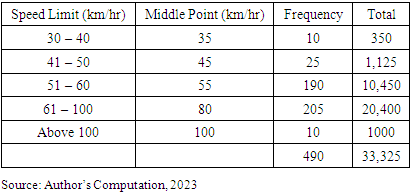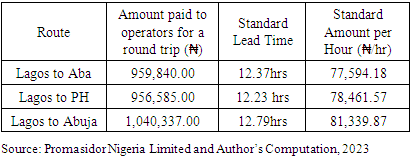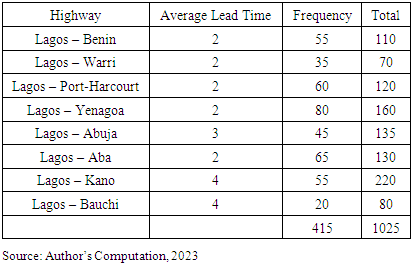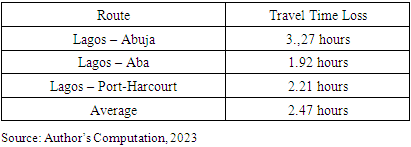Olikagu Chibueze Anthony, Ibe Callistus Chukwudi, Ejem Agwu Ejem, Uzondu Chinebuli
Department of Transport Management Technology, Federal University of Technology, Owerri, Owerri, Imo State, Nigeria
Correspondence to: Olikagu Chibueze Anthony, Department of Transport Management Technology, Federal University of Technology, Owerri, Owerri, Imo State, Nigeria.
| Email: |  |
Copyright © 2024 The Author(s). Published by Scientific & Academic Publishing.
This work is licensed under the Creative Commons Attribution International License (CC BY).
http://creativecommons.org/licenses/by/4.0/

Abstract
This study aims to estimate the direct economic impact of poor road infrastructure disruptions on Road Freight Systems (RFS) in Nigeria. The essentiality of road freight movement to various cities in Nigeria has resulted to various disruptions especially poor road infrastructure this study investigates. There is seemingly high travel time loss and the increased maintenance cost by RFS as a result of poor road infrastructure in Nigeria. This invariably affects RFS and nation’s economy, hence the need to estimate the extent of the impact. Stratified random sampling was used to select Lagos - Port-Harcourt highway through the East-West road, Lagos - Aba highway, and Lagos - Abuja highway as a sample population while an experimental design was adopted using questionnaires to obtain the needed data for the study. Cost accounting information was equally extracted from Promasidor Nigeria Limited and Federal Road Safety Commission (FRSC) of Nigeria. A study adopted descriptive statistics as a method of data analysis. The study concludes that RFS loses about $7.8 billion annually to poor road infrastructure. The significance of this study is that annual disruption cost represents 1.6% of Nigeria’s Gross Domestic Product (GDP) and 4000 times over the GDP from transport sector.
Keywords:
Direct, Economic, Impacts, Disruptions, Road, Freight, Poor, Road Infrastructure, Travel Time Loss, Gross Domestic Product
Cite this paper: Olikagu Chibueze Anthony, Ibe Callistus Chukwudi, Ejem Agwu Ejem, Uzondu Chinebuli, Estimating the Direct Economic Impacts of Poor Road Infrastructure Disruptions on Road Freight Systems in Nigeria, International Journal of Traffic and Transportation Engineering, Vol. 13 No. 1, 2024, pp. 1-5. doi: 10.5923/j.ijtte.20241301.01.
1. Introduction
A lack of transport opportunities has been shown to be a barrier for accessibility, social inclusion and economic growth in contemporary society. Ibe and Ejem (2019) justified that transport is a social and economic necessity. Transport is fundamental to supporting economic growth, creating jobs and connecting people to essential services such as healthcare or education (WHO, 2023). Ramiani and Shirazian (2019) posited that tremendous growth of population, particularly in developing countries, has led to increased number of travels, especially those with load and freight specifications. Nigeria has a road transportation network made up of about 193,200 kilometers (km) (Federal: 34,123 km; State: 30,500 km, and Local Government: 129,577 km). Of these, there are 60,068 km of paved roads, which follow a grid system of North - South and West – East, the railway gauge is presently narrow, the inland water way, airports and seaports (Ariyo, 2017). Ariyo (2017) further posited that Nigerian roads are the most important means of transportation in the country, carrying about 80% of the population and goods. Public transportation is of no doubt the driving force for activating and stimulating the beat of economic, social, political and strategic growth of any society. However, to accomplish this, public transportation infrastructures must be soundly developed to guarantee the movement of people and goods rapidly, economically, securely, easily and in an environmental-friendly way (Sumaila, 2012). National Bureau of Statistics (NBS) stated that road transportation accounts for more than 90 per cent of the sub-sector’s contribution to the Gross Domestic Product (GDP) in Nigeria. The sufficiency of road transport infrastructure unarguably determines the success or failure in production diversification, trade expansion, managing population growth, poverty reduction, and enthroning environmental friendliness of a country.On the other hand, these objectives are disrupted by externalities yielding to higher cost and huge economic impacts both to road users, consumers, producers and operators. Disruption is said to occur when there is an unplanned stoppage in the movement of goods, both finished and work in progress goods within a supply chain (Revilla & Saenz, 2017). Sound transportation policy decisions that will enthrone viable economic development can only be achieved by the identification and quantification of the economic and social impacts of disruptions. Disruptions no matter how is defined pose direct short or long term impacts that include but not limited to fatalities, infrastructure destruction and economic loss. Immediate economic impacts result from the inability of travelers and businesses to adapt to changed circumstances after a disruption (Mesa-Arango, 2013). Any road in bad shape leads to negative economic effects. The total economic effects of such bad road to the nation, the health of the citizens, operation of businesses, safety of lives and properties are unquantifiable (Enwerem & Ali, 2016). Any investment in the reconstruction and proper maintenance of Nigerian roads will enormously ease road transportation of goods and services and improve on the standard of living of the citizens. A Central Bank of Nigeria (CBN) research finding held that: “The annual loss due to bad roads is valued at ₦80 billion, while additional vehicle operating cost resulting from bad roads is valued at ₦53.8 billion, bringing the total loss per annum to ₦133.8 billion according to Central Bank of Nigeria (2003). The state and condition of the road network, infrastructure, assets and facilities in Nigeria are extremely dire and this is having a negative impact on virtually all socio-economic activities in the country (Odeku, 2020).The absence of sustainable and functional multi-modal transport in Nigeria has resulted to the over dependency on Road Freight System (RFS) as a veritable means of conveyance of goods from the depots to various cities. Transportation infrastructure is one of the most important types of infrastructure since the improvements in transportation infrastructure has tangible and intangible benefits to economy such as reducing costs, increasing productivity and outputs. Numerous contemporary research works have added to empirical knowledge concerning transportation infrastructure as a facilitator and important contributor to a nation’s economic development (Gwilliam, 2013). Road transportation infrastructure underlies the more visible forms of capital, facilitating the delivery of inputs to places of production and the delivery of finished goods to marketplaces (Agbigbe, 2016). Road transportation infrastructure plays key role equally in social services, providing access to schools, hospitals, and places of employment. Agbigbe (2016) further concluded that given the capital-intensive nature of road transportation infrastructure and the increasing scarcity of resources for capital-intensive projects it is vital to comprehend the effects of road transportation infrastructure investments on the overall economy of a growing country. There is burgeoning literature directed at the relationship between road networks investment and economic development in developed countries such as the United States and United Kingdom (Nobrega & Stich, 2012). Akhmetzhanov and Lustoy (2013) demonstrated links between transportation infrastructure and regional development with respect to population movements. Another related strand of the literature concerns the effects of intercity transportation infrastructure, highways, and high-speed railroads, on economic activities such as urbanization and suburbanization (Duranton & Turner, 2012), and firms’ transactions (Datta, 2012). These previous studies have established the positive relation between the economic impacts of disruptions posed by transport infrastructure on road freight system. This study will consider the outcome of field results in establishing the empirical results of the direct impacts of poor road infrastructure on RFS.
2. Methodology
The study gave a national picture of the 32,100km of federal road in the country using the 696 kilometers route connecting the commercial city of Lagos through Benin and the East-West road to Port-Harcourt, 705 kilometers Lagos to Aba and 750 kilometers Lagos to Abuja. An experimental design was adopted to estimate the various impacts since it involved various forms of data gathering. An experimental design was adopted to estimate the various impacts since it involved various forms of data gathering. The research engages the use of electronically distributed questionnaires (google forms) to 520 drivers in order to obtain data including the time per stop, and the total number of stops on the various selected corridors using tallying system. The study adopted descriptive statistics to determine the average increased cost of repairs as a result of poor road infrastructure, travel time loss and number of disrupted spaces as a result of poor road infrastructure. Cost accounting information, the Average Annual Daily Traffic (AADT) and the economic benchmark on the selected highways were extracted from published documents of Promasidor Nigeria Limited, Federal Road Safety Corp (FRSC), and National Bureau of Statistics (NBS) respectively. The three sample roads selected for the study has a total road length of 2151 kilometers representing 6.7 % out of a total of 32,100 kilometers federal road network. Nigeria is subdivided into various geo political spaces. In order to embrace the national outlook, a stratified random sampling was used to select one major highway in different major regions. Lagos is the origin representing the Western part of Nigeria, Port-Harcourt, Abuja and Aba are the various destinations representing the Southern, Northern and Eastern parts of Nigeria. Hence, the study was carried on the corridors of these federal roads connecting these cities.
3. Results and Discussions
The study identified the direct cost elements of poor transport infrastructure as; maintenance cost of the trucks, idle time cost, and towing cost. The study surveyed the time spent in various bad spots along the 705km Lagos to Aba route, 734km Lagos to Abuja (ABJ) route and 696km Lagos to Port-Harcourt through East-West road. The survey of prices paid by Fast Moving Consumer Goods (FCMG) to logistics operators in Nigeria was carried out for the selected highways and is summarized in table 3.1. A survey of the speed limit as shown in table 3.2 was equally carried to establish the average speed limit (asl) of 68km/hr using statistical means. The ASL was further subjected to computation to establish the lead time with an allowance of additional 2 hours in consideration of section 16.9 of Safety Requirements/ Guidelines for Articulated Tankers/ Trailers Operations in Nigeria which made it mandatory for drivers to rest for 30 minutes in every 4 hours. The derived lead time for various selected routes as shown in table 3.3 was used to determine the standard cost per hour per selected route as shown in table 3.4. Table 3.1. Cost of Transportation of Commodities from Lagos to Aba, Abuja and Port-Harcourt (PH)
 |
| |
|
Table 3.2. Survey of Speed Limit by Trucks/Trailers
 |
| |
|
 | (1) |
 ASL = 68km/hr
ASL = 68km/hrTable 3.3. Lead Time of Trucks/Trailers
 |
| |
|
Table 3.4. Transportation Cost per Hour
 |
| |
|
Table 3.5. Assessment of Travel Time Loss on Lagos – Abuja highway
 |
| |
|
Table 3.6. Assessment of Travel Time Loss on Lagos- Port-Harcourt Highway
 |
| |
|
Table 3.7. Assessment of Travel Time Loss on Lagos - Aba Highway
 |
| |
|
Table 3.8. Average Cost by Severe Potholes per Trip
 |
| |
|
3.1. Estimation of the Total Cost of Travel Time Cost on Severe Potholes
Table 3.9 revealed the survey of lead time in Nigeria as a measure of the variances from the calculated standard lead time in table 3.3. The result shows that it an average lead time for road freight from origin to destination in Nigeria is 3.5 days (84 hours) according to the field survey. This is against the calculated 12.46 hours indicating a disruption of 71.54 hours per trip. The surveyed lead time implied that it takes about 7 days to complete a full trip (with returns) representing an average 48 turns per annum. This implies that a truck losses about 118.56 hours of travel time per annum to severe pot holes occasioned by poor transport infrastructure as demonstrated in table 3.10. The cost of travel time loss by road freights due to severe potholes is estimated as shown in table 3.11 using the 649,946 average annual truck traffic.Table 3.9. Survey of Lead Time in Nigeria
 |
| |
|
Following equation one: | (1) |
The average lead time is calculated as:

Table 3.10. Average Travel Time Loss per Route
 |
| |
|
Table 3.11. Computation of Cost of Severe Potholes
 |
| |
|
3.2. Estimation of the Increased Maintenance Cost caused by Poor Road Infrastructure
Table 3.12 revealed the survey of lead time in Nigeria as a measure of the variances from the calculated standard lead time in table 3.13. Annual loss from vehicle maintenance on trucks due to bad roads is valued at over ₦157 billion according to our findings. This was derived by the simulation of the increase in Average Maintenance Cost per Truck by ₦242,924.52 per annum and the Average Annual Daily Truck Traffic of 649,946 trucks.Table 3.12. Assessment of Increased Cost of Maintenance
 |
| |
|
Following equation one: | (1) |
The average maintenance cost of trucks due to bad roads is calculated as:
Table 3.13. Estimation of Increased Maintenance Cost caused by Poor Transport Infrastructure
 |
| |
|
4. Conclusions
The main aim of this study is to estimate the direct economic impact of disruptions on road freight systems in Nigeria. From the findings, it can be concluded that the study finds evidence of the impacts of poor roads infrastructure on travel time loss and increased maintenance cost of vehicles. Good roads infrastructure makes transportation of goods easier which is the center of economic development. It was therefore concluded that poor transport infrastructure disruptions impact strongly and negatively on road freight system with an annual direct economic impact of about $7.8 billion in Nigeria. Good road infrastructure facilitate through transportation and timely delivery of goods from the distribution center to various cities. It helps reduce maintenance, fuel and running cost on transport and reduce travel time loss. It is without doubt that improvement in road infrastructure will improve the Gross Domestic Product of Nigeria. The significance of this study shows that 1.6% of the Gross Domestic Product (GDP) is lost to poor road infrastructure in Nigeria. It equally reflects that disruptions from poor road infrastructure are estimated to be over 4000 times higher than the GDP from transport sector. It strongly calls for successive governments and decision making authorities to improve the GDP of the nation through investment in road transport infrastructure. A reasonable approach to tackle the issues of disruption in Nigeria is to reduce the vehicular density on our highways especially high axle weight vehicles. This can be achieved by diversifying or utilizing other modes of transportation. The study therefore recommends as follows:1. Creating a functional multimodal system to reduce pressure on the highways. This can easily be achieved by utilizing the vast inland waterways in Nigeria and the use trains; and2. Zero tolerance and rapid response on fixing severe potholes on nation’s highways by the responsible agencies.
References
| [1] | Agbigbe, W. C. (2016). The Impact of Transportation Infrastructure on Nigeria's Economic Development. Walden Dissertations and Doctoral Studies Walden Dissertations and Doctoral Studies Collection. |
| [2] | Akhmetzhanoy, B. A., & Lustoy, N. S. (2013). High-speed mainlines and their contribution to regional development. Problems of Economic Transition, 56(3), 44-48. https://doi.org://10.2753/PET1061-1991560305. |
| [3] | Ariyo, A. (2017). Public Transport Policy in Developing Countries: Nigeria as a Case Study. 1st International Conference of the School of Management Technology (SMAT). Federal University of Technology, Akure, Nigeria. 28th – 31st March, 2017. |
| [4] | Central Bank of Nigeria (2003). Highway Maintenance in Nigeria; Lessons from Other Countries. Research Department Occasional Paper No. 27. |
| [5] | Datta, S. (2012). The impact of improved highways on Indian firms. Journal of Development Economics. 99(1), 46-57. https://doi.org//:10.1016/j.jdeveco.2011.08.005. |
| [6] | Duranton, G., & Turner, M. A. (2012). Urban growth and transportation. The Review of Economic Studies. 79(4), 1407-1440. https://doi.org://10.1093/restud/rds010. |
| [7] | Enwerem, G.C., & Ali G.A. (2016). Economic Effects of Bad Roads on Vehicle Maintenance in Nigeria. International Journal of Scientific and Research Publications. 6(6). |
| [8] | Gwilliam, K. (2013). Cities on the move–Ten years after. Research in Transportation Economics. 40(1), 3-18. https://doi.org://10.1016/j.retrec.2012.06.032. |
| [9] | Ibe, C., & Ejem, A. (2019). Empirical analysis of private car preference to public transport modes in owerri, Imo State, Nigeria. Port Harcourt Journal of Sciences. |
| [10] | Mesa-Arango (2013). Estimating the economic impacts of disruptions to intermodal freight systems traffic. USDOT Region V Regional University Transportation Center Final Report. NEXTRANS Project No. 053PY03. |
| [11] | Nobrega, R., & Stich, B. (2012). Toward long-term recovery in Mississippi: understanding the impact of the transportation system on economic resilience. Leadership and Management in Engineering. |
| [12] | Odeku, K.O, (2020). Poor road infrastructure: An impediment to tourism in Nigeria. African Journal of Hospitality, Tourism and Leisure. 9(2). |
| [13] | Ramiani B., & Shirazian G., (2019. Ranking and Determining the Factors Affecting the Road Freight Accidents Model. Civil Engineering Journal 6 (5). |
| [14] | Revilla, E. & Saenz, M. (2017). The impact of risk management on the frequency of supply chain disruptions: a configurational approach. International Journal of Operations and Production Management. |
| [15] | Sumaila, A. (2012). Sustainable transportation management for Federal Capital Territory (FCT) Abuja. Paper Presented at a One-Day Retreat for Staff of FCT Transportation Secretariat. |
| [16] | World Health Organization (2023). Global Status Report on Road Safety 2023. http://www.un.org/ar/roadsafety/pdf/roadsafetyreport.pdf. |




 ASL = 68km/hr
ASL = 68km/hr




 Abstract
Abstract Reference
Reference Full-Text PDF
Full-Text PDF Full-text HTML
Full-text HTML











